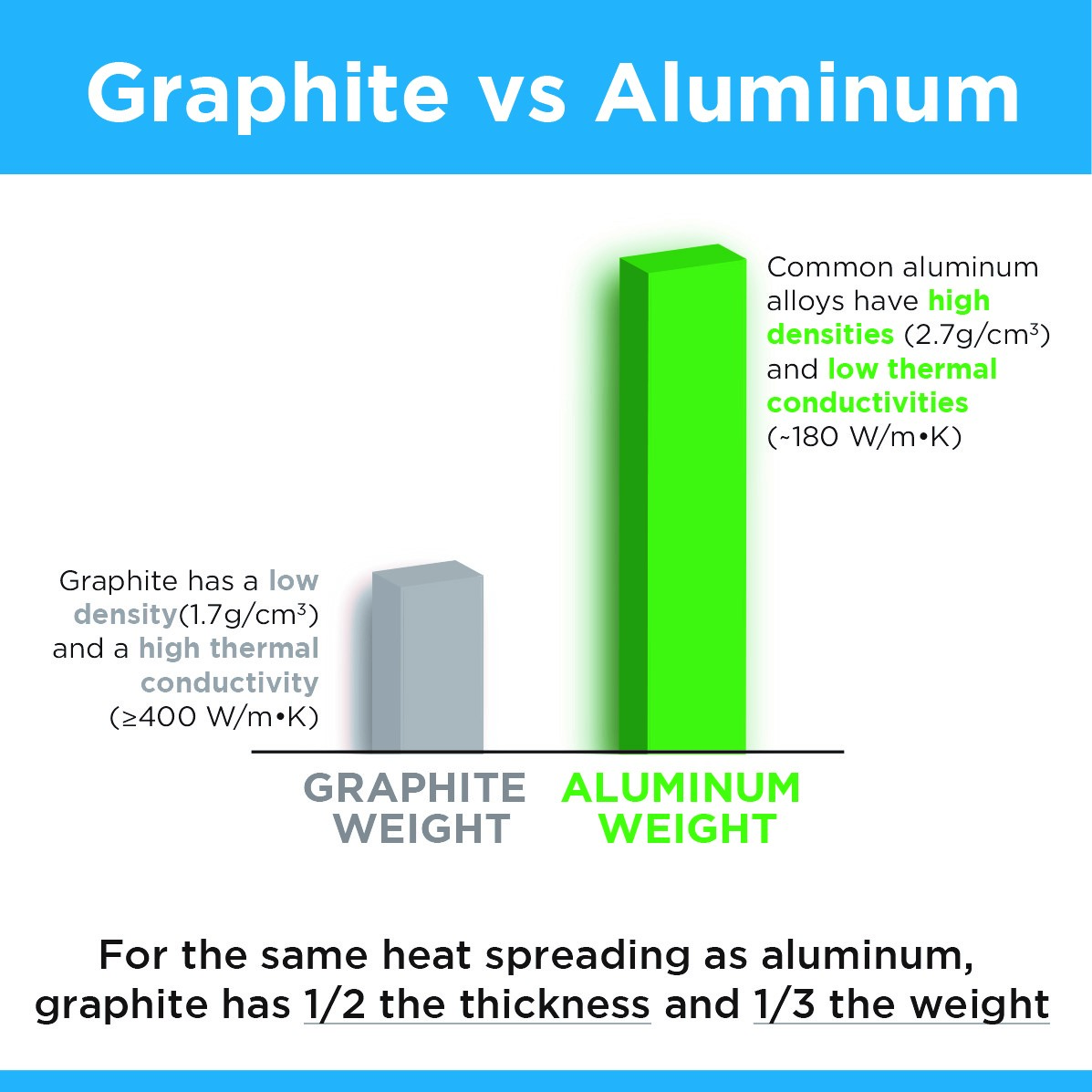Introduction
The consumer electronics industry experienced a revolution in thermal management starting in the
mid-2000s and ending in the late-2010s. Prior to about 2006, mobile phones, laptops, cable set-top-boxes, and large-screen TVs were thick, bulky, and heavy devices that primarily relied on thermal management metals such as aluminum and copper to spread the heat of hot components.
With the introduction of the smartphone in 2007, consumers were introduced to devices that could perform complicated tasks without the weight and bulk associated with previous generations of mobile phones. Within a few years, these design features became essential elements in all high-end consumer electronics.
One of the main drivers in achieving these thin and lightweight form factors was the introduction of NeoGraf Solutions’ SpreaderShield™ flexible graphite heat spreaders. With this new material, introduced to the consumer electronics industry in 2002, designers were able to eliminate thick and heavy metal chassis and heat sinks.
Today, thin and lightweight computers, tablets, phones, and TVs are the standard rather than the exception. Manufacturers worldwide have standardized the use of flexible graphite for most thermal management applications.
The Importance of Thermal Management
Not surprisingly, in battery-powered electric vehicles – ePlanes, drones, eVTOL, maritime, or automotive, the overall performance of the vehicle is usually determined by the battery itself. Variables such as charge rate, range per charge, safety, and cell cycle lifetime are functions of the thermal management design of the battery pack.
To perform at their optimum, battery cells need to be kept at an ideal temperature at all times. A well-thought-out and executed thermal strategy will result in a pack that can be charged quickly, has an extended range per charge, will not propagate, and has cells that last for many years. Thermal management materials are often the single largest factor in the overall weight of a battery pack, apart from the cells themselves. Choosing the right materials quickly became a vital element in battery pack design.
The Increasing Need for Safety
When it comes to safety in an electric vehicle, the most important aspect is controlling the massive amount of energy stored in the battery pack. To help with this, significant advances have been made in cell design and battery management systems (BMS). However, even with these advances, the possibility of a single-cell failure is always present. In the worst-case scenario, the failure of a single cell will cause the failure of the cells near it through overheating. If this occurs, all of the cells in a pack can fail in a cascade of thermal events.
Regulations are starting to be established to control or prevent these thermal runaway events. Unfortunately, the most common method for controlling thermal propagation is to increase the amount of thermal management materials. This has only added to the weight and thickness of the proposed “safer” battery packs.
Evolution of Thermal Management Materials
In many early battery-powered electric vehicles, cell temperatures were controlled by aluminum. It was a time-tested thermal management material, it was relatively inexpensive, and it could take on some of the structural duties of the battery pack.
Unfortunately, aluminum was a relatively poor conductor of heat and was very dense. Thick plates of the metal were needed to provide even basic thermal management. Battery pack designers soon learned that the use of aluminum resulted in designs that were unacceptably thick and heavy. (Figure 1)

Battery pack designers recognized aluminum’s drawbacks and began looking for alternative thermal management materials. Taking a cue from the electronics industry, flexible graphite began to be used in volume maritime battery applications starting in the early 2010s. This usage rapidly spread throughout the industry.
Why Graphite?
To spread the same amount of heat as an aluminum plate, SpreaderShield flexible graphite is only half of the thickness and one-third of the weight. This results in battery packs that are significantly smaller in size and lighter in weight while providing the same amount of energy as aluminum.
One of the major factors in range per charge, acceleration, and braking is the overall weight of the vehicle. Switching to graphite from aluminum can easily shed over one hundred pounds from the battery pack.
Many cells expand and contract as they go through their charging and aging cycles. Aluminum plates have difficulty maintaining thermal contact with the cells during the expansion while flexible graphite easily maintains thermal contact, no matter how much the cells expand or contract.
Graphite Becomes More Vital
To overcome the problems caused by trying to use aluminum to cool cells in battery-powered vehicles, battery pack designers have turned to flexible graphite. Today, SpreaderShield flexible graphite is used commercially in electric automobiles (EVs), snowmobiles, jet skis, ships, and ePlanes. As safety, performance, and fast charging requirements continue to tighten, the demand for thin and lightweight graphite will only continue to grow.
# # # #
Bret Trimmer
Applications Engineering Manager – NeoGraf Solutions

